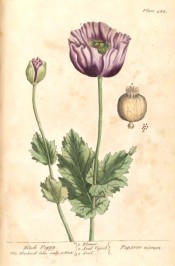Papaver somniferum L.
Fully hardy, erect annual with solitary, bowl-shaped, pink, mauve-purple, red or white flowers in spring and summer. There are a number of ornamental garden forms, including paeony-flowered hybrids. Cultivated for the milky sap produced in their seed capsules, the source of opium and its derivatives, such as heroin and morphine and other powerful narcotics and analgesics. The seeds have also been used for medicinal and culinary purposes since antiquity. To 1.2m. [RHSE, Hortus].
Horticultural & Botanical History
Paxton’s and Johnson’s Dictionary list six varieties distinguished both by the colour and form of the flowers and the colour of the seeds. [PD, JD]. Don. Elizabeth Blackwell describes and figures two forms of Papaver somniferum that she distinguishes as Black Poppy, Papaver nigrum, and White Poppy, Papaver album, the two forms having distinctive medicinal uses. Both are described here but the Black Poppy is identical with the plant naturalised at Camden Park and throughout the Camden district and is illustrated here. ‘Black Poppy. Papaver nigrum. The stalk grows about three foot high, the leaves are a willow green, and the flowers a pale purple with a black blotch. It is sown yearly in gardens and flowers in July. The heads were formerly used in the Siripus e Meconio, but are left out in the last edition of the Dispensatory. The leaves are used in cooling ointments, being accounted good for burns, inflammations, and hot swellings; and are put in the Unguentum Populeon.’ [Blackwell pl.482/1739]. ‘White Poppy. Papaver album. The stalks grow about a foot high, the leaves are a pale green, and the flowers white. It is sown in fields and gardens and flowers in June. From the heads of these poppies, (in Turkey) the Opium of our shops is produced; by making incisions into them, the milky juice which comes from the wounds, is soon thickened by the heat of the sun, and then gathered and made into lumps. Opium is the greatest Anodine we have, easing pain, procuring sleep, stopping all violent evacuations; and is an excellent medicine in the hands of the wise man; and ought never to be prescribed by any other; many fatal accidents ensuing from the immoderate or unseasonable use of it. The Syrupus Meconio or Diacodium is made of the poppy heads dryed, infused & boiled in water. The seeds are much used in emulsions being cooling and good in fevers, inflammatory distempers, the Stranguary and heat of urine.’ [Blackwell pl.483/1739].
History at Camden Park
Listed only in the 1850 and 1857 catalogues [H.176/1850]. Possibly introduced as much for its pharmaceutical value as its usufulness as a garden ornamental. Widely naturalised as a weed in the Camden area and in the gardens of Camden Park.
Notes
Published Feb 08, 2009 - 02:02 PM | Last updated Jul 29, 2010 - 01:56 PM
| Family | Papaveraceae |
|---|---|
| Category | |
| Region of origin | Widely naturalised around the world, origin unknown. |
| Synonyms | |
| Common Name | Opium poppy |
| Name in the Camden Park Record | Papaver somniferum |
| Confidence level | high |


